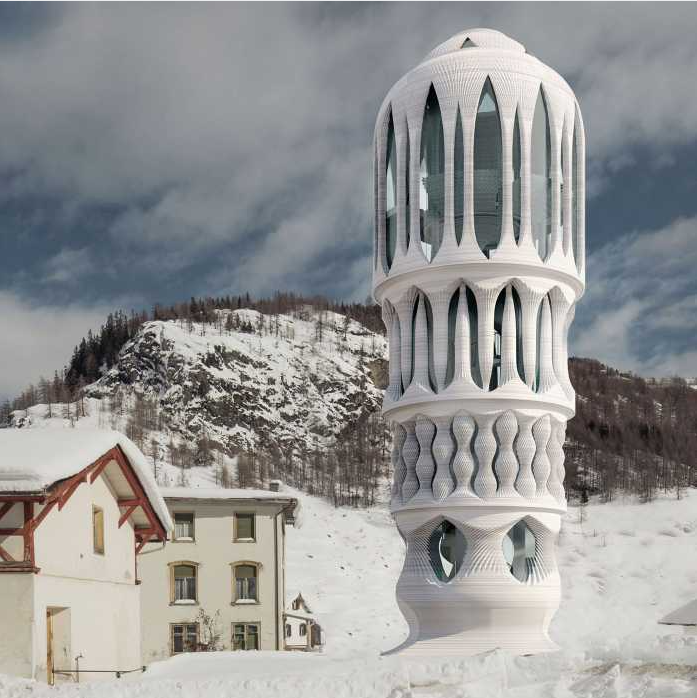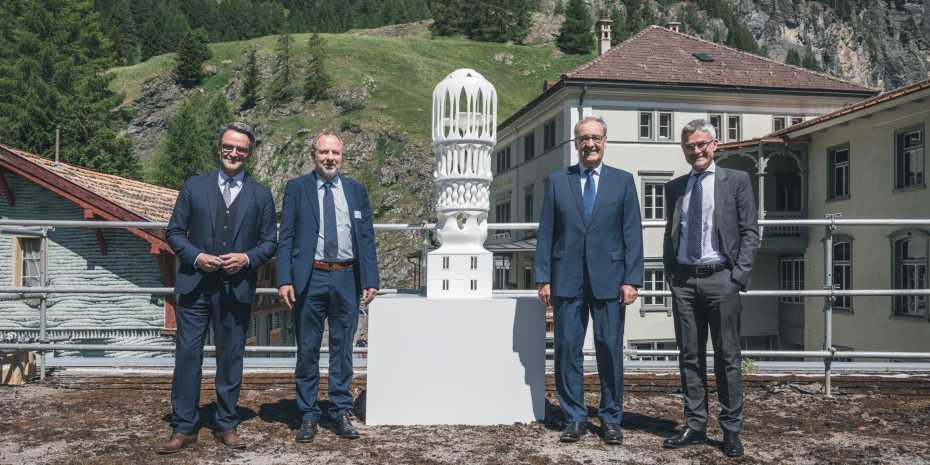Architects and engineers from ETH Zurich are planning to build a 23-meter high tower made up of 3D printed columns which will become a cultural site in the small village of Mulegns in Switzerland.
The project’s goal is to revitalize the area, which is home to just 16 inhabitants, and to strengthen the association between culture, research and technology development, according to ETH Zurich’s Vice President for Research, Detlef Günther: “Because new knowledge often emerges where various disciplines meet.”
The tower will be built using robotic 3D printers on-site, and at 75 feet will supposedly be one of the tallest ever 3D printed structures built by robots.

“Eggshell” 3D printing with ETH Zurich
For concrete to be 3D printed in a construction setting, it typically needs to be supported by formwork as it transitions from a fluid material into a solid, which can be costly. Orthogonal structures also remain the norm, with many buildings constructed using more material than is really needed. While FDM 3D printing has shown promise within construction applications, the method’s speed, scale, and inability to produce thin printed structures to hold the concrete in place has somewhat prevented its widespread adoption.
In July 2020, researchers from ETH Zurich fused robotic large-scale FDM 3D printing with casting methods to devise a novel “eggshell” concrete 3D printing process. The technology enabled the team to produce complex structures in a more material-efficient way while also minimizing the lateral pressure on the material to allow for printed sculptures with more complex geometries.
By merging large-scale robotic FDM 3D printing with a set-on-demand digital casting system, developed from the Smart Dynamic Casting (SDC) method designed by an earlier Zurich team in 2014, the team could create more complicated structures using a thin, single-layered shell as formwork.
Working with German engineering firm Basler & Hofmann, the Zurich team deployed the fabrication process to create a 3D printed “future tree” in the courtyard of the company’s headquarters, the columns of which were found to be self-supporting within a couple of hours.
ETH Zurich has also previously been involved in several other construction projects, having partnered with Zaha Hadid Architects to create a five-tonne 3D printed curved shell concrete pavilion, and digitally fabricating a three-storey house using 3D printers and robotic arms.

Printing the White Tower
The rejuvenation project in Mulegns is the brainchild of Giovanni Netzer, Theatre Director and Founder of the Origen cultural festival. Together with the Origen foundation, ETH Zurich Professor Benjamin Dillenburger and Michael Hansmeyer from the Digital Building Technologies research group have designed the tower, which will consist mainly of organically-shaped 3D printed white concrete columns.
The columns support four floors that are each between four and eight meters in height and form a dome at the top of the tower within which will be a stage where plays, dance performances and concerts will be held.
Three other ETH professors from the National Center of Competence in Research (NCCR) Digital Fabrication are also involved in the development of the tower alongside Dillenburger. Robert Flatt is in charge of mixing the printable concrete material, Walter Kaufmann is responsible for the structural integrity and connections of the printed parts, and Andreas Wieser will focus on the metrology and inspection elements of the build.
Construction of the tower is due to begin on-site in April 2022. The robotic printer will reportedly be capable of printing a three-meter high column in just two hours, and each 3D printed element will be engineered so that the tower can be dismantled and rebuilt in another location.
Using 3D printing for the build will enable the complex geometries of the columns to be produced and, through negating the need for formwork, will also require the use of fewer raw materials.

Concrete 3D printing
3D printing is being increasingly utilized within the construction sector to provide enhanced material features, lower manufacturing timescales and costs, and improve material efficiencies during the construction of new buildings.
A number of advances have occurred in this area in recent years, with researchers from UC Berkeley working on a new method of incorporating 3D printed polymer octet lattices into concrete structures as a reinforcement, making the weight of the structure lighter while retaining essential load-bearing capabilities.
Elsewhere, researchers at the University of Sri Jayewardenepura in Sri Lanka and Northumbria University in the UK have identified the optimal parameter set for 3D printing flame-retardent concrete walls, and scientists at the Swinburne University of Technology and Hebei University of Technology have sought to improve sustainability within the sector by repurposing construction waste into 3D printable concrete.
In May, a research team from the Polytechnic University of Valencia developed a patented 3D printed alternative to reinforced concrete beams in the form of 3D printed plastic blocks that can be assembled like lego bricks and concreted in place.
Subscribe to the 3D Printing Industry newsletter for the latest news in additive manufacturing. You can also stay connected by following us on Twitter and liking us on Facebook.
Looking for a career in additive manufacturing? Visit 3D Printing Jobs for a selection of roles in the industry.
Subscribe to our YouTube channel for the latest 3D printing video shorts, reviews and webinar replays.
Featured image shows render of the exterior view of the 3D printed White Tower in Mulegns. Image via Hansmeyer/Dillenburger.



